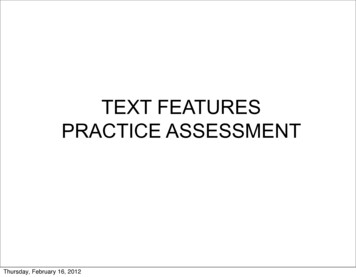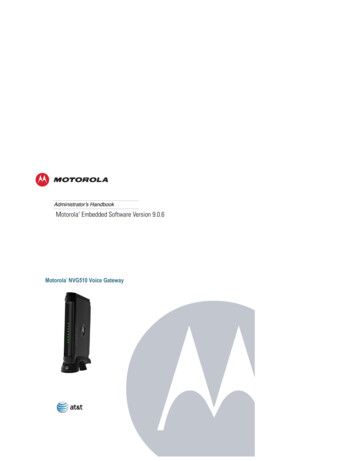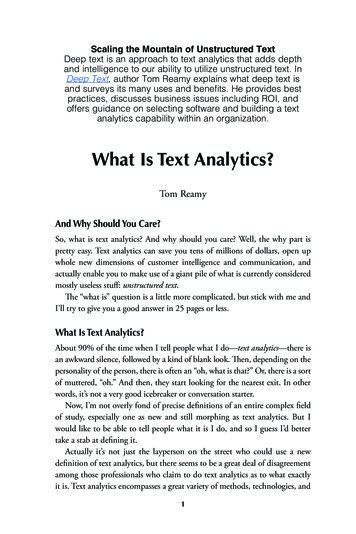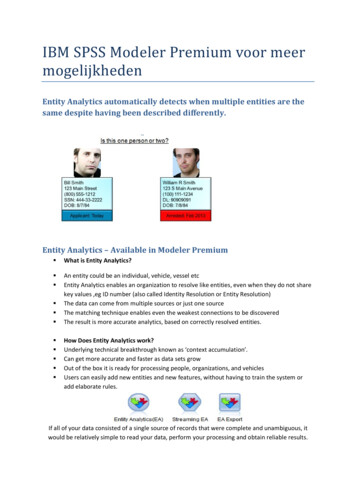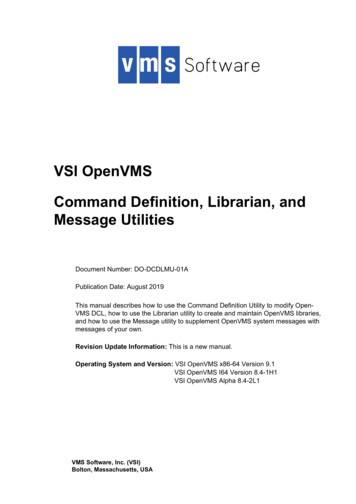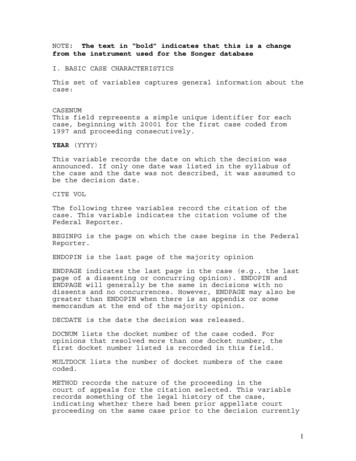
Transcription
NOTE: The text in “bold” indicates that this is a changefrom the instrument used for the Songer databaseI. BASIC CASE CHARACTERISTICSThis set of variables captures general information about thecase:CASENUMThis field represents a simple unique identifier for eachcase, beginning with 20001 for the first case coded from1997 and proceeding consecutively.YEAR (YYYY)This variable records the date on which the decision wasannounced. If only one date was listed in the syllabus ofthe case and the date was not described, it was assumed tobe the decision date.CITE VOLThe following three variables record the citation of thecase. This variable indicates the citation volume of theFederal Reporter.BEGINPG is the page on which the case begins in the FederalReporter.ENDOPIN is the last page of the majority opinionENDPAGE indicates the last page in the case (e.g., the lastpage of a dissenting or concurring opinion). ENDOPIN andENDPAGE will generally be the same in decisions with nodissents and no concurrences. However, ENDPAGE may also begreater than ENDOPIN when there is an appendix or somememorandum at the end of the majority opinion.DECDATE is the date the decision was released.DOCNUM lists the docket number of the case coded. Foropinions that resolved more than one docket number, thefirst docket number listed is recorded in this field.MULTDOCK lists the number of docket numbers of the casecoded.METHOD records the nature of the proceeding in thecourt of appeals for the citation selected. This variablerecords something of the legal history of the case,indicating whether there had been prior appellate courtproceeding on the same case prior to the decision currently1
coded. The variable takes the following values:1 decided by panel for first time (no indication ofrehearing or remand).2 decided by panel after re-hearing (i.e., this is thesecond time this case has been heard by this same panel).3 decided by panel after remand from Supreme Court4 decided by court en banc, after single panel decision5 decided by court en banc, after multiple panel decisions6 decided by court en banc, no prior panel decisions7 decided by panel after remand to lower court (e.g., anearlier decision of the court of appeals remanded the caseback to the district court which made another decision. Thatsecond decision of the district court is now before thecourt of appeals on appeal).8 other9 not ascertainedNote:i) coders generally assumed that the case had been decidedby the panel for the first time if there was no indicationto the contrary in the opinion.ii) the opinion usually, but not always explicitly indicateswhen a decision was made "en banc" However, if more than 3judges were listed as participating in the decision, thedecision was coded as en banc even if there was no explicitdescription of the proceeding as en banc.CIRCUITThis field records the circuit of the court that decided thecase. The District of Columbia circuit is coded as 00 andall other circuits by their numberSTATEThis field records the state or territory in which the casewas first heard. If the case began in the federal districtcourt, it is the state of that district court. If it is ahabeas corpus case, it is the state of the state court thatfirst heard the case. If the case originated in a federaladministrative agency, the variable is coded as "notapplicable." States were assigned a two digit number inalphabetical order (see list for codes)STATES00 not determined01 Alabama02 Alaska03 Arizona04 Arkansas05 California06 Colorado07 Connecticut08 Delaware09 Florida10 Georgia2
11 Hawaii12 Idaho13 Illinois14 Indiana15 Iowa16 Kansas17 Kentucky18 Louisiana19 Maine20 Maryland21 Massachussets22 Michigan23 Minnesota24 Mississippi25 Missouri26 Montana27 Nebraska28 Nevada29 New Hampshire30 New Jersey31 New Mexico32 New York33 North Carolina34 North Dakota35 Ohio36 Oklahoma37 Oregon38 Pennsylvania39 Rhode Island40 South Carolina41 South Dakota42 Tennessee43 Texas44 Utah45 Vermont46 Virginia47 Washington48 West Virginia49 Wisconsin50 Wyoming51 Virgin Island52 Puerto Rico53 District of Columbia54 Guam55 not applicable - case from court other than US DistrictCourt or state court (e.g., appealed from regulatory agency)56 Panama Canal Zone57 North Mariana IslandsDISTRICTFor all cases that were appealed to the courts of appealsfrom the federal district court, this variable records whichdistrict in the state the case came from. Thus, to identify3
a particular district court of interest, one would have tocombine this variable with the preceeding variable (STATE).For cases that did not come from a federal district court,the variable is coded as not applicable. The variable takesthe following values:0 not applicable - not in district court1 eastern2 western3 central4 middle5 southern6 northern7 whole state is one judicial district8 not ascertainedORIGINThis field records the type of court which made the originaldecision (cases removed from a state court are coded asoriginating in federal district court). The variable takesthe following values:1 federal district court (single judge)2 3 judge district court3 state court (includes habeas corpus petitionsafter conviction in state court; also includes petitionsfrom courts of territories other than the U.S. DistrictCourts)4 bankruptcy court, referee in bankruptcy, special master5 federal magistrate6 originated in federal administrative agency7 special DC court (i.e., not US District Court for DC)8 other (e.g., Tax Court, a court martial)9 not ascertained10 Tax Court11 ALJSOURCEThis field identifies the forum that heard this caseimmediately before the case came to the court of appeals.Note that often the SOURCE and ORIGIN will be the same. Thevariable takes the following values:1 federal district court (single judge)2 3 judge district court3 state court4 bankruptcy court or referee in bankruptcy5 federal magistrate6 federal administrative agency7 Court of Customs & Patent Appeals8 Court of Claims9 Court of Military Appeals10 Tax Court or Tax Board11 administrative law judge12 U.S. Supreme Court (remand)13 special DC court (i.e., not the US District4
Court for DC)14 earlier appeals court panel15 other16 not ascertained17 bankruptcy appellate panel (BAP)DISTJUDGThis field identifies the federal district court judge (ifany) that heard the case in the original trial. See theseparate list of district judge codes.APPLFROMThis field records the type of district court decision orjudgment appealed from (i.e., the nature of the decisionbelow in the district court). If there was no prior districtcourt action, the variable is coded as not applicable. Thevariable takes the following values:1 trial (either jury or bench trial)2 injunction or denial of injunction or stay of injunction3 summary judgment or denial of summary judgment4 guilty plea or denial of motion to withdraw plea5 dismissal (include dismissal of petition for habeascorpus)6 appeals of post judgment orders (e.g., attorneys' fees,costs, damages, JNOV - judgment nothwithstanding theverdict, also code JAML here – judgment as a matter of law)7 appeal of post settlement orders8 not a final judgment: interlocutory appeal9 not a final judgment : mandamus10 other (e.g., pre-trial orders, rulings on motions,directed verdicts) or could not determine nature of finaljudgment.11 does not fit any of the above categories, but opinionmentions a "trial judge"12 not applicable (e.g., decision below was by a federaladministrative agency, tax court)*If a criminal case and the only issue on appeal concernsthe sentence, then coded as “6”ADMINREVThis field records the federal agency (if any) whosedecision was reviewed by the court of appeals. If there wasno prior agency action, the variable is coded as notapplicable. The variable takes the following values:1 Benefits Review Board2 Civil Aeronautics Board3 Civil Service Commission4 Federal Communications Commission5 Federal Energy Regulatory Commission6 Federal Power Commission7 Federal Maritime Commission5
8 Federal Trade Commission9 Interstate Commerce Commission10 National Labor Relations Board11 Atomic Energy Commission12 Nuclear Regulatory Commission13 Securities & Exchange Commission14 other federal agency15 not ascertained or not applicable*If case is from federal district court, then coded “15”PRIORPUBThis field records the citation of the most recent (if any)published opinion of some other court or a prior decision ofthe courts of appeals for this same case. If there was noprior published opinion, the field will be treated as amissing value. Each citation takes the following form: anumeric volume number, followed by an alphanumericabbreviation of the reporter, followed by a numeric pagenumber on which the decision starts. The following were themost frequently used abbreviations for reporters:FS Federal SupplementF2nd Federal Reporter, 2ndseriesrdF3d Federal Reporter, 3 seriesTC Tax CourtSC United States Supreme CourtBR Bankruptcy CourtFRD Federal Rules DecisionsAll other abbreviations that appear use the format of theBlue Book of the Uniform System of Citation.OPINSTATThis field records whether there was an opinion in which theopinion writer was identified or whether the opinion was percuriam. The variable takes the following values:1 signed, with reasons2 per curiam, with reasons9 not ascertainedCLASSACTThis field is a dummy variable that records whether the casewas described in the opinion as a class action suit. Thevariable takes the following values:0 the opinion does not indicate that this was a classaction suit1 the opinion specifically indicates that the action wasfiled as a representative of a class or of "all otherssimilarly situated."CROSSAPPThis field is a dummy variable that records whether therewere cross appeals from the decision below to the court ofappeals that were consolidated in the present case. The6
variable takes the following values:0 no cross appeals1 yes, cross appeals were filed2 not ascertainedSANCTIONThis field records whether there were sanctions imposed onone of the litigants by the court of appeals. The variabletakes the following values:0 no sanctions1 sanctions imposed on appellant2 sanctions imposed on respondent3 sanctions imposed on both appellant and respondent4 not ascertainedINITIATEThis field records which of the parties below initiated theappeal. For cases with cross appeals or multiple docketnumbers, if the opinion does not explicitly indicate whichappeal was filed first, the coding assumes that the firstlitigant listed as the "appellant" or "petitioner" was thefirst to file the appeal. In federal habeas corpuspetitions, the prisoner is considered to be the plaintifffor purposes of this variable. The variable takes thefollowing values:1 original plaintiff2 original defendant3 federal agency representing plaintiff4 federal agency representing defendant5 intervenor8 not applicable9 not ascertainedTREATThis field records the disposition by the court of appealsof the decision of the court or agency below; i.e., how thedecision below is "treated" by the appeals court. That is,this variable represents the basic outcome of the case forthe litigants and indicates whether the appellant orrespondent "won" in the court of appeals. The variable takesthe following values:0 stay,petition, or motion granted1 affirmed; or affirmed and petition denied2 reversed (include reversed & vacated)3 reversed and remanded (or just remanded)4 vacated and remanded (also set aside & remanded; modifiedand remanded)5 affirmed in part and reversed in part (or modified oraffirmed and modified)6 affirmed in part, reversed in part, and remanded;affirmed in part, vacated in part, and remanded7 vacated8 petition denied or appeal dismissed9 certification to another court7
10 not ascertained11 affirmed, vacated (with no mention of reverse), andremanded8
II. PARTICIPANTS CODINGNote: for these fields, intervenors who participated asparties at the courts of appeals are counted as eitherappellants or respondents when it could be determined whoseposition they supported. For example, if there were twoplaintiffs who lost in district court, appealed, and werejoined by four intervenors who also asked the court ofappeals to reverse the district court, the number ofappellants was coded as six.AppellantsIn some cases there is some confusion over who should belisted as the appellant and who as the respondent. Thisconfusion is primarily the result of the presence ofmultiple docket numbers consolidated into a single appealthat is disposed of by a single opinion. Most frequently,this occurs when there are cross appeals and/or when onelitigant sued (or was sued by) multiple litigants that wereoriginally filed in district court as separate actions.The coding rule followed in such cases was to go strictly bythe designation provided in the title of the case. The firstperson listed in the title as the appellant was coded as theappellant even if they subsequently appeared in a seconddocket number as the respondent and regardless of who wascharacterized as the appellant in the opinion.To clarify the coding conventions, consider the followinghypothetical case in which the US Justice Department sues alabor union to strike down a racially discriminatoryseniority system and the corporation (siding with theposition of its union) simultaneously sues the government toget an injunction to block enforcement of the relevant civilrights law. From a district court decision that consolidatedthe two suits and declared the seniority system illegal butrefused to impose financial penaltieson the union, the corporation appeals and the government andunion file cross appeals from the decision in the suitbrought by the government. Assume the case was listed in theFederal Reporter as follows:United States of America,Plaintiff, AppellantvInternational Brotherhood of Widget Workers,AFL-CIODefendant, Appellee.International Brotherhood of Widget Workers,AFL-CIODefendants, Cross-appellantsvUnited States of America.Widgets, Inc. & Susan Kuersten Sheehan, President & Chairmanof the BoardPlaintiff, Appellants,vUnited States of America,Defendant, Appellee.9
This case would be coded as follows:Appellant United StatesRespondents International Brotherhood of Widget WorkersWidgets, Inc.NUMAPPEL 1APPFED 1NUMRESP 3R BUS 2R NONP 1APPEL1 31010RESPOND1 21006RESPOND2 14400NUMAPPELThis field records the total number of appellants in thecase. If the total number cannot be determined (e.g., if theappellant is listed as "Smith, et. al." and the opinion doesnot specify who is included in the "et.al.") then 99 isrecorded. This variable was directly recorded by the coders- it was not generated by taking the sum of the next sevenvariables that record the number of appellants falling intoseven specific categories. The value forthis variable sometimes does not equal the sum of the nextseven variables. The most common reasons that NUMAPPEL doesnot equal the sum of the specific categories (in approximateorder offrequency) are: a) NUMAPPEL will equal 99 whenever any oneof the next seven variables equals 99; b) there is an errorin one of the eight variables; 3) there were appellants whodid not fit any of the specific categories (e.g., the firstappellant is an Indian tribe, APPEL1 82001).The structure of each field in this group is the same as thestructure of the preceding variable (NUMAPPEL). Each fieldrecords the number of appellants in the present case thatfell into the designated general category of appellants. Ifthe total number cannot be determined (e.g., if theappellant is listed as "Smith, et. al." and the opinion doesnot specify who is included in the "et.al.") then 99 isrecorded in the category (in this exampleAPPNATPR 99). The types of appellants recorded in each fieldareas follows:APPNATPR natural personsAPPBUS private business and its executivesAPPNONP groups and associationsAPPFED the federal government, its agencies, and officialsAPPSUBST sub-state governments, their agencies, andofficialsAPPSTATE state governments, their agencies, and officialsAPPFIDUC fiduciariesNote that if an individual is listed by name, but theirappearance in the case is as a government official, then10
they are counted as a government rather than as a privateperson. For example, in the case "Billy Jones & Alfredo Ruizv Joe Smith" where Smith is a state prisoner who brought acivil rights suit against two of the wardens in the prison(Jones & Ruiz), the followingvalues would be coded: APPNATPR 0 and APPSTATE 2. A similarlogic is applied to businesses and associations. Officers ofa company or association whose role in the case is as arepresentative of their company or association are coded asbeing a business or association rather than as a naturalperson. However, employees of a business or a government whoare suing their employer are coded as natural persons.Likewise, employees who are charged with criminal conductfor action that was contrary to the company's policies areconsidered natural persons.If the title of a case listed a corporation by name and thenlisted the names of two individuals that the opinionindicated were top officers of the same corporation as theappellants, then the number of appellants was coded as threeand all three were coded as a business (with the identicaldetailed code). Similar logic was applied when governmentofficials or officers of an associationwere listed by name.APP STID (state code)This field uses the numerical codes for the states (seefield 13, STATE, for a listing of the codes) to indicate thestate of the first listed state or local government agencythat is an appellant.General Classification of appellants and respondents (firstand second listed)This field reports the coding of the first listed appellant.The 9 categories are the same as the first digit of thedetailed coding of the appellants (Note that fieldsGENAPEL2; GENRESP1; and GENRESP2 use the same categories.The variable takes the following values:1 private business (including criminal enterprises)2 private organization or association3 federal government (includes DC)4 sub-state government (e.g., county, local, specialdistrict)5 state government (includes territories & commonwealths)6 government - level not ascertained7 natural person (excludes persons named in their officialcapacity or who appear because of a role in a privateorganization)8 miscellaneous9 not ascertainedBANKRUPTCY (APPNTS OR RESPNDTS)BANK AP111
This field records a dichotomous variable to indicatewhether or not the first listed appellant is bankrupt. Ifthere is no indication of whether or not the appellant isbankrupt, the appellant is presumed to be not bankrupt. Thevariable takes thefollowing values:1 bankrupt2 not bankruptDETAILED CODING OF PARTIESThis field records a five digit code to represent a moredetailed coding of the nature of the first listed appellantthan is provided in GENAPEL1. The following coding scheme isused for the detailed nature of the appellants andrespondents (i.e., APPEL1;APPEL2; RESPOND1; and RESPOND2).Each detailed code has five digits, with different digitsrepresenting different subcategories of information.However, the specific subdivisions (i.e., what informationis provided by each digit of the code) are different fordifferent categories of litigants (e.g., it would make nosense to try to use the same subdivisions for businesses andgovernments) Therefore, instead of presenting a list of 5digit codes in numerical order, the following listing ispresented by general categories of litigants with thesubcategories within each general category listedseparately.When coding the detailed nature of participants coders wereinstructed to use personal knowledge they had about theparticipants, if they were completely confident of theaccuracy of their knowledge, even if the specificinformation used was not in the opinion. For example, if"IBM" was listed as the appellant it could be classified as"clearly national or international in scope" even if theopinion did not indicate the scope of the business.PRIVATE BUSINESS (FIRSTGENERAL CATEGORY, DIGIT1 1)Digit 2 what is the scope of this business?Code 1, 2, or 3 if clear; otherwise, not ascertained (4)1 clearly local (individual or family owned business –scope; limited to single community; generally proprietors,who are not incorporated, are in this category)2 clearly other-intermediate; neither local nor national(e.g., an electrical power company whose operations coverone-third of the state)3 clearly national or multi-national in scope (note:insurance companies and railroads were assumed to benational in scope)4 not ascertainedDigit 3 what category of business best describes the areaof activity of this litigant which is involved in this case?12
(for example, Agriculture)Digits 4 & 5 provide subcategories of each of these businesscategories. These subcategories are listed under theappropriate category.Example: a single family farm is coded as 11101Example: General Motors, when appearing in case as anautomobile manufacturer is coded 13401.1 Agriculture01 single family farm02 commercial farm, agri-business03 farm - other00 not able to classify subcategory2 mining01 oil and gas02 coal03 metals04 other00 not able to classify subcategory3 construction01 residential02 commercial or industrial03 other00 not able to classify subcategory4 manufacturing01 auto02 chemical03 drug04 food processing05 oil refining06 textile07 electronic08 alcohol or tobacco09 other00 not able to classify subcategory5 transportation01 railroad02 boat, shipping03 shipping freight, UPS, flying tigers04 airline05 truck (includes armored cars)06 other00 not able to classify subcategory6 trade - wholesale and retail01 auto, auto parts, auto repairs02 chemical03 drug04 food13
05060708091000oil, natural gas, gasolinetextile, clothingelectronicalcohol or tobaccogeneral merchandiseotherunable to classify subcategory7 financial institution01 bank02 insurance03 savings and loan04 credit union06 other pension fund07 other financial institution or investment company00 not able to classify subcategory8 utilities01 nuclear power plants02 other producers of power (or producers of power wheremeans of production is not clear)03 telephone04 other utilities00 not able to classify subcategory9 other (includes service industries)01 medical clinics, health organizations, nursing homes,medical doctors, medical labs, or other private healthcare facilities02 private attorney or law firm03 media - includes magazines, newspapers, radio & TVstations and networks, cable TV, news organizations04 school - for profit private educational enterprise(includes business and trade schools)05 housing, car, or durable goods rental or lease; long termtypically includes contract06 entertainment: amusement parks, race tracks, for profitcamps, record companies, movie theaters and producers,ski resorts, hotels, restaurants, etc.07 information processing08 consulting09 security and/or maintenance service10 other service (includes accounting)11 other (includes a business pension fund)00 not able to categorize0 unclear (not ascertained)01 auto industry - unclear whether manufacturing, trade,etc.02 chemical industry - unclear whether manufacturing, trade,etc.03 drug industry- unclear whether manufacturing, trade, etc.04 food industry - unclear whether manufacturing, trade,etc.14
05 oil & gas industry - unclear whether manufacturing,trade,etc.06 clothing & textile industry - unclear whethermanufacturing, trade, etc.07 electronic industry - unclear whether manufacturing,trade, etc.08 alcohol and tobacco industry - unclear whethermanufacturing,etc.09 other00 unable to classify litigantPRIVATE ORGANIZATIONORASSOCIATION (SECONDGENERAL CATEGORY;DIGIT 1 2)Digit 2 -what category of private associations bestdescribes this litigant?Digits 3-5 describe specific subcategories of organizationsExample: American Bar Association 210041 business, trade, professional, or union (BTPU)001 Business or trade association002 utilities co-ops003 Professional association - other than law or medicine004 Legal professional association005 Medical professional association006 AFL-CIO union (private)007 Other private union008 Private Union - unable to determine whether in AFL-CIO009 Public employee union- in AFL-CIO(include groups called professional organizations iftheir role includes bargaining over wages and workconditions)010 Public Employee Union - not in AFL-CIO011 Public Employee Union - unable to determine if inAFLCIO012 Union pension fund; other union funds (e.g., vacationfunds)013 Other000 Not able to categorize subcategory2 other001 Civic, social, fraternal organization002 Political organizations - Other than political partiesExamples: Civil rights focus; Public Interest - broad,civil liberties focus (ACLU) or broad, multi-issue focus(Common Cause, Heritage Foundation, ADA) or single issue- Environmental ENV, Abortion, etc. (prolife,pro-abortion), elderly, consumer interests: ConsumerFederation of America, Consumer's Union, NationalRailroad Passenger Association; PAC003 Political party15
004 Educational organization - Private, non-profit school005 Educational organization - Association, not individualschool - PTA or PTO006 Religious or non-profit hospital or medical carefacility (e.g., nursing home)007 Other religious organization (includes religiousfoundations)008 Charitable or philanthropic organization (includingfoundations, funds, private museums, private libraries)009 Other000 Not able to categorize subcategoryFEDERALGOVERNMENT(THIRDGENERAL CATEGORY; DIGIT1 3)Digit 2 -which category of federal government agencies andactivities best describes this litigant?Digits 3 - 5 list specific government agencies falling intothe categories in digit 2.Example: Chairman of the Joint Chiefs of Staff 310031 cabinet level department001 Department of Agriculture002 Department of Commerce003 Department of Defense (includes War Department andNavy Department)004 Department of Education005 Department of Energy006 Department of Health, Education and Welfare007 Department of Health & Human Services008 Department of Housing and Urban Development009 Department of Interior010 Department of Justice (does not include FBI or paroleboards; does include US Attorneys)011 Department of Labor (except OSHA)012 Post Office Department013 Department of State014 Department of Transportation, National TransportationSafety Board015 Department of the Treasury (except IRS)016 Department of Veterans Affairs2 courts or legislative001 one or both houses of Congress002 congressional committee003 officer of Congress or other Congress related actor004 Federal District Court (or judge)005 Federal Circuit Court of Appeals (or judge)006 Court of Claims (or judge)007 Tax Court (or judge)008 Bankruptcy Court (or judge)009 other court or judge16
3 agency whose first word is "federal"001 Federal Aviation Administration002 Federal Bureau of Investigation (FBI)003 Federal Coal Mine Safety Board004 Federal Communications Commission005 Federal Deposit Insurance Corporation and FSLIC006 Federal Election Commission007 Federal Energy Agency (Federal Power Commission)008 Federal Energy Regulatory Commission009 Federal Home Loan Bank Board010 Federal Housing Authority (FHA)011 Federal Labor Relations Authority012 Federal Maritime Board013 Federal Maritime Commission014 Federal Mine Safety & Health Administration015 Federal Mine Safety & Health Review Commission016 Federal Reserve System017 Federal Trade Commission4 other agency, beginning with "A" thru "E"001 Benefits Review Board002 Civil Aeronautics Board003 Civil Service Commission (U.S.)004 Commodity Futures Trading Commission005 Consumer Products Safety Commission006 Copyright Royalty Tribunal007 Drug Enforcement Agency008 Environmental Protection Agency009 Equal Employment Opportunity Commission5 other agency, beginning with "F" thru "N"001 Food & Drug Administration002 General Services Administration003 Government Accounting Office (GAO)004 Health Care Financing Administration005 Immigration & Naturalization Service (includes borderpatrol)006 Internal Revenue Service (IRS)007 Interstate Commerce Commission (now, the SurfaceTransportation Board)008 Merit Systems Protection Board009 National Credit Union Association010 National Labor Relations Board011 Nuclear Regulatory Commission6 other agency, beginning with "O" thru "R"001 Occupational Safety & Health Administration002 Occupational Safety & Health Review Commission003 Office of the Federal Inspector004 Office of Management & Budget005 Office of Personnel Management006 Office of Workers Compensation Program17
007 Parole board or parole commisssion, or prisonofficial, or US Bureau of Prisons008 Patent Office009 Postal Rate Commission (U.S.)010 Postal Service (U.S.)011 RR Adjustment Board012 RR Retirement Board7 other agency, beginning with "S" thru "Z"001 Securities & Exchange Commission002 Small Business Administration003 Veterans Administration004 SSA(for Surface Transportation Board, see ICC above)8 District of Columbia000 DC in its corporate capacity001 legislative body for DC local government002 mayor, agency head or top administrator003 bureaucracy providing service004 bureaucracy in charge of regulation005 bureaucracy in charge of general administration006 judicial007 other9 other, not listed, not able to classify000 United States - in corporate capacity (i.e., asrepresentative of "the people") - in criminal cases001 United States - in corporate capacity - civil cases0
6 northern . 7 whole state is one judicial district . 8 not ascertained _ ORIGIN _ This field records the type of court which made the original decision (cases removed from a state court are coded as originating in federal district court). The variable takes the following values: 1 federal district court (single judge) 2 3 .




